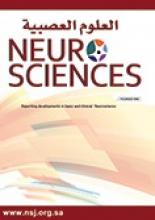Abstract
OBJECTIVE: Sleep is a known activator of epileptiform discharges on electroencephalography. Chloral hydrate is used frequently for electroencephalography sedation. Our objectives were to study the value and limitations of chloral hydrate.
METHODS: One hundred and fifty nine consecutive pediatric electroencephalograms were included prospectively. One electroencephalography technologist collected chloral hydrate related data. Electroencephalogram requisitions and recordings were reviewed separately by one certified electroencephalographer.
RESULTS: The children’s ages ranged between 8 days to 19 years (mean=5.7 years). Natural sleep was recorded in 11% and only 2% were sleep deprived. Sedation was given to 45% mostly using chloral hydrate (96%). Children with chronic neurological abnormalities were more likely to receive chloral hydrate (odds ratio=9.8, 95% confidence interval=4.5-21). Chloral hydrate was effective in inducing sleep in 97%, however, 34% of the children woke up spontaneously before the test was completed, particularly those with chronic neurological abnormalities (p=0.0003). A second dose was necessary in 13%. Recording an initial period of wakefulness followed by sleep onset was more likely achieved in natural sleep electroencephalograms when compared to the sedated group (82% vs 10%, p<0.0001). These electroencephalograms were more likely to contain epileptiform discharges (p<0.001).
CONCLUSION: Although chloral hydrate was effective in sleep induction, the sleep onset was frequently missed and the hypnotic effects were not sustained, particularly in children with chronic neurological abnormalities.
- Copyright: © Neurosciences
Neurosciences is an Open Access journal and articles published are distributed under the terms of the Creative Commons Attribution-NonCommercial License (CC BY-NC). Readers may copy, distribute, and display the work for non-commercial purposes with the proper citation of the original work.






